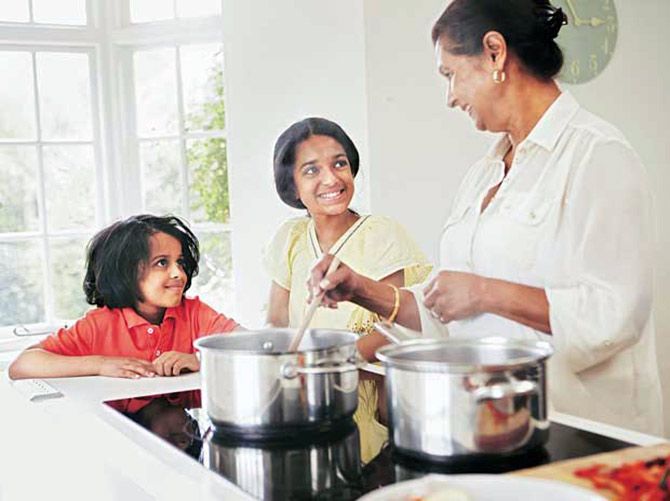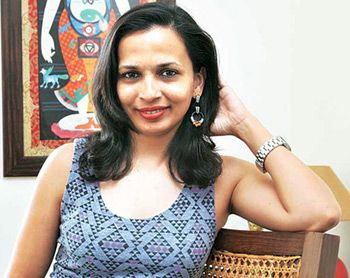'If you are eating a samosa, be honest about that decision.
Adding only one teaspoon oil to it will not make it healthy.'
Celebrated nutritionist Rujuta Diwekar may have gathered her expertise from universities, the Himalayas and Australia, but her approach to nutrition is driven by her grandmother.

 If your grandmother remembers eating something, you can eat it. That is the thumb rule," says Rujuta Diwekar, left.
If your grandmother remembers eating something, you can eat it. That is the thumb rule," says Rujuta Diwekar, left.
The sports science and diet guru scoffs at fads like counting calories or switching to brown rice, relying mainly on ayurveda and tradition instead.
In her new book, Indian Superfoods, Diwekar offers local alternatives to foods such as kale or goji berries that are hailed internationally as having health benefits.
One of these foods, for instance, is kokum, which is presented in the form of sherbet to guests in her airy office in Khar.
Seated amid prayer flags and images of the Buddha, Diwekar goes on to counter various dietary myths.
Sugar is actually good for us
The sweet granules are increasingly being seen as bitter rivals to health, but Diwekar insists they do no harm.
It is only added sugars contained in packaged foods like biscuits that are of a very low quality.
Rather than cutting down on certain types of sugar, people have started cutting it out altogether, she rues.
Traditionally a part of celebrations, the saccharine substance has her vote of confidence.
As she often does, Diwekar refers one to past wisdom. Coughs have traditionally been cured with khadi shakkar (rock sugar) and sugarcane juice helps those with jaundice.
Her book goes on to dismiss claims that sugar is linked with diabetes and weight gain.
Instead of serving cookies at meetings, Diwekar recommends switching to fruits like the banana, which she rates as a superfood.
She does throw in a warning about drinking fruit juices because they deliver fruit sugar in large doses that evolution has not yet taught our bodies to deal with.
Brown rice does not score over white rice
Brown rice is just wrong, Diwekar says. "You hate the taste and it takes ages to cook."
No food should be broken down to just carbs, proteins or fats; that is a disservice to people.
Rice consumed with other legumes, pulses and ghee makes a healthy meal.
Hand-pounded, single-polished rice -- which is more similar to white rice than brown rice -- is ideal, says the nutritionist.
Unlike popular belief, such rice reportedly contains the optimum amount of fibre that helps assimilate nutrients like vitamin B12 and zinc.
Brown rice, with its high fibre, could seemingly get in the way of mineral absorption.
The air fryer is counter-productive
For Diwekar, the difference between deep-frying and air-frying is the same as the difference between a kiss and a flying kiss.
Certain foods are best enjoyed deep-fried, she says, and there is wisdom to the use of ghee.
It is a good fatty acid, which slows down the climb in blood sugar from shankar pala, mathri or even luchis which are made with fibre-less maida.
This, in turn, is said to make it easy for the body to assimilate herbs and spices in these snacks.
The body has an intuitive process of what to eat when -- for instance, it craves bhajiyas during the rain.
It is okay to give in to it at such times, she says. "If you are eating a samosa, be honest about that decision. Adding only one teaspoon oil to it will not make it healthy."
Grandmother's science will always win
Although people think they are eating healthy, it is not helping much, reckons the nutritionist.
The problem, according to her, is because medical advice changes its messages every year.
She cites in her book the example of the United States Food and Drug Association, or USFDA, admitting in 2015 that there is no link between cholesterol and heart disease -- even if it had suggested otherwise since the 1970s.
"We have a storehouse of wisdom at home. We should regard that as information of value," she says.
Local is more important than organic
Local is just another word for safe, in Diwekar's view.
Food should spend the least amount of time in transit.
We ought to be consuming food from the nearest farms, and which is so fresh that it will go bad within days, she says.
It is problematic that most varieties of produce are available throughout the year, and ingredients that are not natural to the region are finding their way to more shelves.
"Demand must not decide what we grow. The seasons should decide what grows and what we eat," notes Diwekar. "We have forgotten riders like don't eat greens during the rains."
The other problem, she notes, is the prestige attached with exotic ingredients, whereby local food is seen as the poor man's food.











